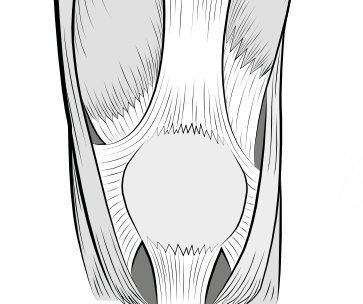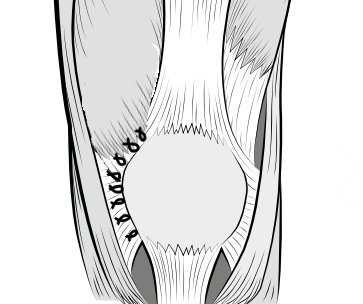Medial reefing is a surgical procedure to tighten the tissues on the medial aspect of the patella. It is being used less and less as studies show it is not very effective.
 Page updated January 2024 by Dr Sheila Strover (Clinical Editor)
Page updated January 2024 by Dr Sheila Strover (Clinical Editor)


Why has medial reefing traditionally been performed?
Medial reefing tightens up the superficial layers on the medial side of the patella to try and better align the patella in its underlying groove, and also to counter any excessive patellar instability that may have resulted from a prior lateral release. But it has not proven very effective and is being replaced with medial patellofemoral ligament reconstruction (MPFL-R ).
Relationship of medial reefing to lateral release
Medial reefing has often been performed in association with lateral release or lateral retinacular lengthening in patients who have problems with instability of the patella. Because lateral release surgery has in the last two decades fallen out of favour, medial reefing is no longer that commonly performed.
Why MPFL reconstruction is nowadays preferred to medial reefing
MPFL reconstruction may be done after a patellar dislocation event has torn the medial patellofemoral ligament. The procedure uses a harvested ligament and bone tunnels in both patella and femur. It gives a strong reconstruction but is quite invasive. Medial reefing, in contrast, tightens up the soft tissues in the same area without using bone tunnels.
Quick links
Forum discussions
- Kirsten's TTT, LR, and medial reefing Post-Op Diary 11/19/08
A patient's diary after a medial reefinf procedure.
Peer-reviewed papers
-
Quote:
"Taking into consideration the negative impact on patella stability and the poor clinical results of isolated lateral release, we believe that the combined arthroscopic procedure [of medial reefing and lateral release] should no longer have a place in the management of patients with chronic patellofemoral instability."
Citation: Schorn D, Yang-Strathoff S, Gosheger G, Vogler T, Klingebiel S, Rickert C, Andreou D, Liem D. Long-term outcomes after combined arthroscopic medial reefing and lateral release in patients with recurrent patellar instability - a retrospective analysis. BMC Musculoskelet Disord. 2017 Jun 24;18(1):277. doi: 10.1186/s12891-017-1636-8. PMID: 28646869; PMCID: PMC5483275.
Relevant material -
- Maltracking
- Lateral release
- Lateral retinacular lengthening
- Medial patello-femoral ligament
- MPFL reconstruction
From other Experts -
- Journal interpretation - 2016 - Outcomes After Isolated Medial Patellofemoral Ligament Reconstruction for the Treatment of Recurrent Lateral Patellar Dislocations - Peer-reviewed publication by Schneider DK et al., 'interpreted' by Dr Sheila Strover (Clinical Editor)
 2019 -
2019 -